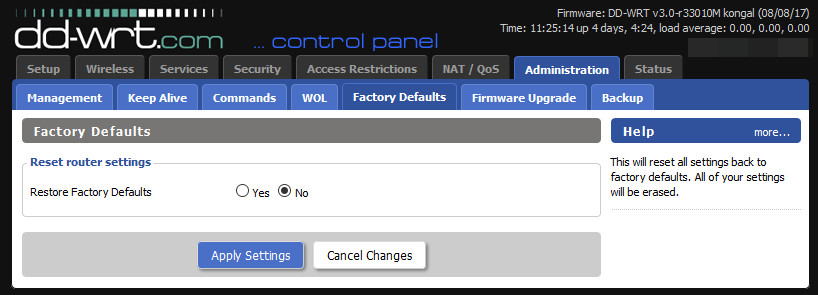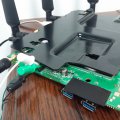One common question that we see around the forums is simply: how do I flash my NETGEAR router with DD-WRT? The world of open source firmware but can definitely be overwhelming for newcomers to the scene. Fortunately, flashing DD-WRT to your NETGEAR router is often much easier than it might seem at first, with a few of the terms and steps made clearer. Here's how to get started.
Important Note: This is a high level guide with general steps that may not cover all router models or DD-WRT versions. Please check the developer's information for the firmware you are choosing to ensure that any "special" steps are followed, if applicable.
Step 1: Identify your NETGEAR router model.
This is a crucial step, definitely do not overlook this! The exact router model can usually be found on a sticker or nameplate on the back or bottom of the unit. The model number will be something like "WNDR3700," "R8000," "R9000," or similar. Some NETGEAR routers have updated versions, such as the R6400 and R6400v2. Some of these "v2" or higher models are very similar to their predecessors -- but use different hardware -- meaning a different DD-WRT build is needed.
Step 2: Identify the proper firmware to flash.
Once you have determined with certainty the exact model of router in your possession, and its version, the next step is to find the firmware you need to flash. Upgrading a router from stock NETGEAR firmware generally uses a different file than upgrading from an existing DD-WRT installation.
There are three different types of firmware flash file DD-WRT typically uses:
- .CHK -- This format is used by NETGEAR in their own stock firmware builds, and also used by DD-WRT builds as an "initial flash file" for many supported NETGEAR routers.
- .IMG -- This format is used by some NETGEAR routers, such as the R9000, when upgrading from stock firmware to DD-WRT. Sometimes, an additional flash is needed to bring the router up to date, with a .BIN file.
- .BIN -- This format is typically used to upgrade an existing DD-WRT installation with a newer version.
The firmware downloads section on MyOpenRouter will help to guide you in finding the proper version to install. For example, a download for the R7800, in the description, notes that it is a .BIN file for upgrading from a previous DD-WRT installation, and the link for the initial flash file (if you are flashing from stock.) You should also consult the documentation and/or release notes from the developer providing the firmware build for any special notes or instructions not covered here.
Once again note that if you have a different version, e.g. a v2, it's crucial that the proper firmware is downloaded and installed -- otherwise the router could become bricked. Similarly, flashing a router with the wrong version from stock (i.e., not the proper initial flash file) can also brick the router. DD_WRT is not available for every router. If you have any questions about which firmware to install, or if DD-WRT is available for your model, please consult the forums or the firmware developer.
Finally, it is important to note that, depending on the router model you have and the flavor of DD-WRT that may be available for it, there may be SPECIFIC instructions to that router or build this documentation may not cover. Please refer to the DD-WRT firmware in question to ensure that any special steps are followed that may not be covered in this high level guide.
Step 3: Reset your NETGEAR router to factory defaults.
This can be done either using the reset button on the back of the unit, or through the router interface (usually accessible via 192.168.1.1, or routerlogin.net/routerlogin.com). Some routers may need what is called a 30-30-30 reset.
Step 4: Flash the initial DD-WRT flash file for your NETGEAR router.
After logging in to your NETGEAR router's interface, click on ADVANCED -> Administration -> Router Update. Select the appropriate initial flash file from your computer, and proceed with the upgrade. DO NOT unplug or power down the router during this process. It may take a few minutes.
Step 5: Log into DD-WRT and perform a reset to default settings.

After the flash is complete, log into DD-WRT through a browser by typing 192.168.1.1. Generally, DD-WRT will prompt you to enter your desired username and password to proceed; make note of this in case you get bumped out of the interface. Once in the DD-WRT screen, click the "Administration" tab, then "Factory Defaults." Select to restore to factory defaults, then proceed. Once the router reboots, you should be good to go with your first installation of DD-WRT!
Next Steps

It's important to note that, if your router used an "initial" flash file (usually an .IMG, such as with the R9000) you may need to perform an additional firmware upgrade with the newest .BIN file available. This can be performed in DD-WRT through Administration -> Firmware Upgrade.
DD-WRT is a powerful way to tweak your router, but can be complicated, too! Start a discussion on our forums or ask questions on our community forums if you need help. The DD-WRT wiki is another excellent resource. Have fun!
Category:


So I am already on a Kong build: Firmware: DD-WRT v3.0-r29440M kongac (04/19/16), whiich I did from the factory firmware for my R8000. I am confused as it says one can upgrade to another Kong build if using another version, by using a .bin file, but then instruction says to Reset your NETGEAR router to factory defaults first before flashing the Kong firmware. If I reset to factory, wouldn't I need to then use the .chk file? As it also states "Select to restore to factory defaults, then proceed. Once the router reboots, you should be good to go with your first installation of DD-WRT; so it seems these instructios are for a 1st Time Installation and not an Upgrade?
What are the steps to upgrade from one Kong build to another Kong build?
resetting I to factory simply means reset to default. if on dd-wrt already , you would use .bin
.chk is only for upgrading from netgear stock (original) firmware
resetting I to factory simply means reset to default. if on dd-wrt already , you would use .bin
.chk is only for upgrading from netgear stock (original) firmware
they say to reset your router to defaults for any type of firmware upgrade in case there are incompatible settings between revisions. if there are even minor differences, things can go south pretty quickly (like breaking firmware and needing TTL cable to flash directly (situation I got into a few weeks ago) lol
Yes, reset just means reset the settings in NVRAM.
We old-timers have read this countless time before, and most of us follow this advice.
But, still noone been able to explain how the hell could possibly brick a router if it encounters invalid settings in the NVRAM. ??!!!
Hi, I have just ordered a nice shiny R8000. can you tell me the most stable version of open source?
Also, Looking through your web pages, I believe that I only need to use a .chk file to upgrade from stock Netgear. Can you save the existing firmware first before flashing? And if it all goes pear-shaped, how would I get back to Netgear stock?
Thanks in advance.
I have an R7800 that I'd like to try alternative firmware (DD-WRT, OpenWRT/LEDE) on. Since I expect to be loading stuff that won't work, I want to be sure I know how to unbrick the router if necessary. I've gotten access to the serial console (the 4 pins under the heatsink near the USB ports) and I can talk to the U-Boot (uboot) bootloader when the machine starts up (and the console when it's running).
However, I don't know how to boot or flash an image (for example, one loaded over TFTP). Ideally, I'd be really happy if I knew the command sequence to re-flash the stock firmware from U-Boot. (I can get U-Boot to retrieve the firmware from my TFTP server and put it in memory, but I don't know how to flash it properly.)
Is there a script / example / instructions somewhere to do this?
Thanks!
Ah, after more poking around the 'Net, it appears that you can put U-Boot in a TFTP receiving mode, send the replacement firmware from a machine on the 192.168.1.x net using tftp put , and then it'll flash things properly and reboot.
Bonus update: I was able to flash a self-built LEDE and quick testing suggests that the wireless works at least a little bit. Yay!
What can be done??
I flash current stable build for the Nighthawk R8000 and configured OpenVPN however I am getting a TLS error. Anyone familiar with this issue?
I am getting can not download file
never seen this error
I get the error message that this file is not comptabile with my router. Has anyone found a work around for this? I only bought this router because it was supposed to be supported by DD WRT and other custom firmware.
Just bought a R7800, followed the instructions here - button reset (there are articles stating do not do a 30/30/30 on this router), insatlled the base .img first, latest .bin file (Kong) after. Installed, no problem.
I will be flashing DD-WRT Kong Mod for NETGEAR R6250 (2018-05-31) this is my first time flashing my router, do I need any other updates after initial install
Thanks in advance
flashed my router. all seemed ok. set new user name and password. setup my wirless channels and passwords ect save everything. after a while I get logged out . Now the password and user name i set is
not longer working. any help would be appreciated
I hope you found a solution... but if not, you can get into the router through its back door:
You'll need to remove the case from the router and locate the serial-connect pins on its mainboard. Many routers have a four to six pin header, some only solder points. It may be marked "J232".
Get a USB<—>Serial cable such as the Ftdi - TTL-232r-3v3, install the driver for your OS, identify the Gnd, TX, and Rx pins on the serial header, and connect the cable to the router and your computer.
Then launch a TTY client such as PuTTY in Serial mode (15200, N, 8, 1) and start the router. If you've got the right pins connected, the router will pipe its boot process to your "console" (computer) and you'll get to a Busybox (embedded Linux) prompt \#.
From here, you can do ALL KINDS of things that you can't do from the routers web interface. However, what you need to do is reset the http username and password.
From the prompt, type the command
nvram show | grep user
and it will disgorge all entries containing the word "user." One of them will look something like "http_username". And the entry may be garbage, or just different from what you thought you entered the first time. Issue the command
nvram set http_username=myusername
where "myusername" is the user name you want to use. It may or may not respond with an acknowledgement, but you can re-issue the grep command and see if it "took." If so, issue the command
nvram commit
and Enter.
Do a similar procedure with the password:
nvram show | grep pass
find the entry that's something like "http_password", and fix it just like you did the username. Don't forget to "commit" or it won't stick.
When you're satisfied, type
reboot
and try to get in thru the web interface at http://192.168.1.1 or whatever the "default gateway" address is. Good luck.
How to reflash openwrt from ddwrt on R9000
I'm on a R7500v2, upgrading from DD-WRT v3.0-r34320M kongat (01/02/18), to the 02/15/18 build. We can't keep any settings? Back it up and restore them after the upgrade? I have a lot of customizations i would really prefer to not retype in, as well as ipchains i custom added...
I recently purchased an R8000 and I get the 'non compatible firmware' error.
After digging around it looks like this done on purpose. If it is really the case, I found that totally outrageous and Netgear should be very clear that some of their boxes are indeed not flashable with custom firmwares.
Can you provide links to your research? I'm trying to figure out how to flash mine as well, and am running into similar issues
I flashed my R7800 and it worked great with Kong latest img/bin. The DD-WRT GUI is somewhat confusing, however, I was able to get router working. I wanted to use ExpressVPN service using OpenVPN. Anyone have any experience with that configuration?
I have R7800 that has started dropping WiFi connection every 6-8 minutes.I downgraded from .62 to.52 fw as many forums have suggested,but that didn't help.Should I factory reset also? Will this firmware that y'all suggest help me with this problem ?
I'm not very techie but would love to try to get this 7800 working decently
Please update this article - as it is no longer possible to flash the R8000 using the instructions above!
Hi Deadhomewood -- appreciate your feedback. This is a general, high level guide intended to help most users get started with DD-WRT on their NETGEAR router. Depending on the model or the firmware you are choosing, the developer may provide special instructions so you should always check the release notes, etc. for the firmware you are choosing.
For Kong's R8000 build of DD-WRT, the .CHK file should be flashable from NETGEAR factory firmware (and updated in the future via .BIN files available from Kong's site.) See here and here (Kong's release notes.). If you are having any specific problems with your R8000 and Kong builds, please post to the R8000 open source forum! (Based on some posts there, it seems that problems arise if the update is not allowed to fully complete)
Hi my open rtr team. Have an r7000 v1 I just flashed B.S. 40863, firstly using the factory to dd wrt.chk. followed by a gui re-set to factory defaults. then the webflash.bin file, followed by another gui re-set. am i correct so far team?
wanted to use KONG build in the first place because i understand His are more stable for Broadcom chipsets. Now that i have found them located here now and no where else i have downloaded them. My Question is, must i use the initial.chk file again, or can i just load the dd-wrt.K3_r7000.chk?
Also why does Kong use all .chk flies....that is kind of confusing, while B.S. uses initial.chk....then follows with .bin...seems less confusing?
Finaly Kong mentions to do a manual command line Nvram erase, should i be doing these also for the r7000?
thank You kindly for Your time
Sorry team i meant to say should i now use the initial KONG .chk file first or can i load the Kong build directly from the B.S. build? thank You
Hello,
for some reason, I cannot get my r9000 to take dd-wrt! I've tried several times now, and it just keeps coming back up with the netgear firmware.
Any help would be greatly appreciated.
Thank you.
I updated via wireless. After the reboot I can't connect via wireless because I don't know the password.
I flashed my <strong>Netgear R7000</strong>3 years ago when i was on 1 GB FIOS. I had to keep Verizon's stupid router with my R7000 It worked very well. 1 year ago we moved no Fios I cried for a week over that! to the Charter/Spectrum overpriced 30mbps. At present I have Kong's DD-WRT v3.0-r39960M kongac (06/08/19), Thank you Kong! Please don't take this wrong, NAS keeps disappearing If I go to the router page and click save and apply it reappears. For the life of me I can't straighten it out. I'm using nord vpn. Since <strong>Kong</strong> is retiring I figure flashing my R7000 with Brainslayer might be a good idea. The question I have is do I have to flash the firmware back to Netgear then flash with Brainslayer's DD-WRT? I don't want to brick it Please help! Thanks
Pages